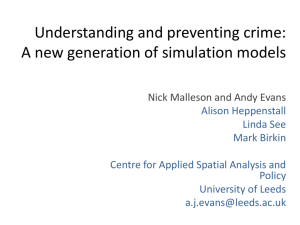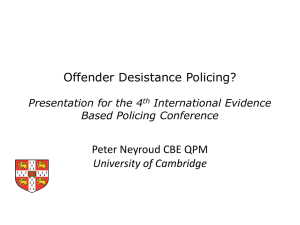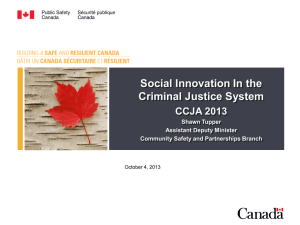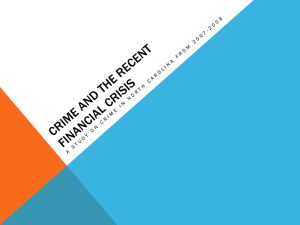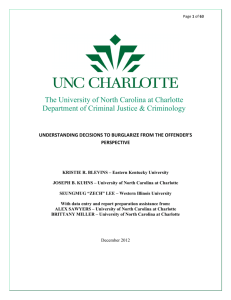Agent-based modelling of UK crime
advertisement
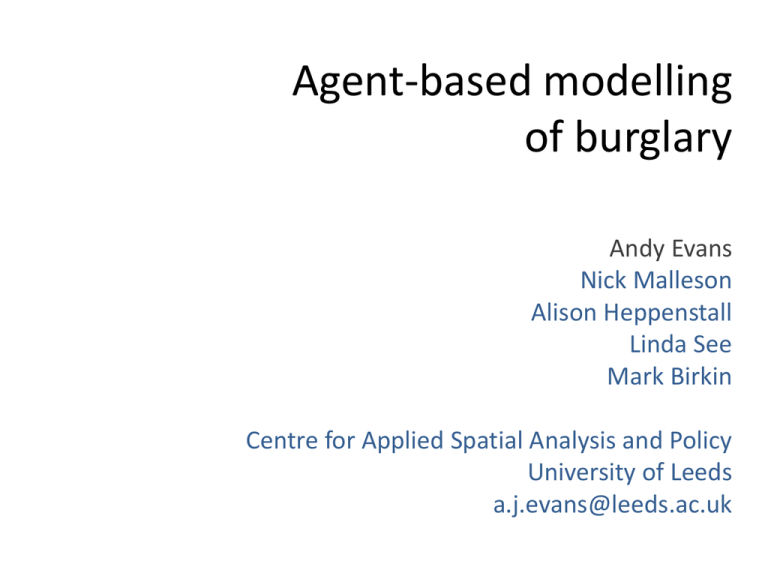
Agent-based modelling of burglary Andy Evans Nick Malleson Alison Heppenstall Linda See Mark Birkin Centre for Applied Spatial Analysis and Policy University of Leeds a.j.evans@leeds.ac.uk Background Ongoing collaboration with SaferLeeds [local police/government crime prevention partnership]. Builds on work using microsimulation and gravity modelling to look at offender-to-target burglary flows. Why burglary? Spatially patterned therefore predictable(?) Spatio-temporally variations key to understanding system. System with history of qualitative theorisation that needs testing. Data good: high numbers of reported crimes and large numbers of convicted offenders. We also have some psychological surveys from local prisons. Largely individually initiated in UK therefore don’t need so much data-poor social interaction modelling. Should be possible to run “what if” tests (specifically, urban regeneration in Leeds). Significant component of fear of crime in UK. Basic model Real geographical environment (S.E. Leeds, UK) Offenders allocated homes and daily routines. Victims communities allocated from census. Offenders have drives including income generation. One way to raise income is burglary. They identify target locations, then search for appropriate and appealing houses. Environment Roads and public transport Ordnance Survey data House/garden geometry MasterMap Topographic Area Layer Ordnance Survey data Community strength and demographics Indices of deprivation / census data Building type National Land Use Database division into broad types, including commercial / social locations Drug dealer locations Real, but randomised within postcode area Victims Basic model: Houses take on demographic characteristics from their census Output Areas (~100 households in each area). Community demographics include economic variables like careers, levels of unemployment, retirement, etc. Also include probabilistic assessments of occupancy for houses in the area at different times of day (based on numbers of employed, unemployed, retired, and students and lifestyle of these groups over the course of a day). Current work: Victims individually microsimulated from census and British Household Panel Survey. Offenders Locations Real offender numbers allocated randomly to households in their real postcodes. Characteristics Offenders allocated employment based on their local characteristics. Work location (if any) chosen from appropriate properties randomly (area of interest reasonably compact – this could be improved with distance to work statistics). Drug supplier and socialisation space allocated randomly (socialisation biased on distance from home). Offender drivers Offenders modelled using the PECS framework (Schmidt,Urban) [Physical conditions; Emotional states; Cognitive capabilities; Social status]. Allows connection of drivers, decision-making/reaction, and behaviour. Drivers: Sleep: 8 hours a day, with desire varying on a diurnal cycle. Drugs: desire varying on a diurnal cycle. Socialisation: desire increasing in evening. Work: travel to and from depending on employment. Character introduced through variation in driver intensity changes, weights of drivers, and behavioural responses. Offender drivers Cash for drug use a near ubiquitous driver in Leeds for burglary (not necessarily true elsewhere) (also socialising). In general, offenders don’t earn enough legitimately to maintain drug consumption. Wealth decays throughout the day (replicating food and housing needs). Income then topped up with burglary. Income from a burglary set to be sufficient for drug consumption and socialisation for a single day. Offender decision making Offenders are reactive to their most significant driver (they don’t weigh drivers up). However, they are then deliberative in finding targets, based on partially-informed rational decisions. Based on Rational Choice Perspective (Clarke and Cornish). Offender behaviour Offenders identify a community that will contain targets. They do this based on areas they know and area attractiveness. Their “awareness space” is built up during their daily routines visiting “anchor points” associated with work, socialisation and drug buying (based on Brantingham and Brantingham’s Geometric Theory of Crime). They then travel to this area by the shortest distance route, searching as they go for easy targets. They take larger risks on targets, the more desperate their drivers. If they don’t find anywhere in a given time, they pick a new area. Choosing victim areas and houses Area Factors Locational Factors Familiarity Dwelling Factors Surveillability The motivated offender Weak Security Victim/Target Factors Lack of Occupancy Proximity Accessibility On major road/ through route Accessibility Source: Hamilton-Smith and Kent, 2005 Suitable Opportunity Goods worth stealing Area attractiveness Act as “optimal foragers”. Pick a community areas to visit. Attraction: Wealth disparity Nearness to home Comfort (closeness in socio-economic variable space). Number of previously successful burglaries in area. Weights of these are calibrated. Route to area Shortest on weighted vector network constructed from road map. Different travel options assigned (walk, public, car). Search on way, then bullseye out from a house picked in the community area. Search shape tear-drop if away from home, bulls-eye around home. Collective efficacy: Target ease Calculated from deprivation and demographic variation. Traffic volume: Calculated using traffic estimates and space syntax. Accessibility: Calculated using property free walls (window/door proxy). Occupancy likelihood: Estimated from community demographics. Visibility: Estimated from garden dimensions and house arrangement. Security: Applied manually from stakeholder discussions. Based on Rational Choice Perspective (Clarke and Cornish) and Routine Activities Theory (Cohen and Felson). Target choice Occupied properties are not burgled. Targets probabilistically picked weighted on ease, area attractiveness, and desperation (more desperate burglars worry less about being recognised close to home). Some weights calibrated. All burglaries are successful. Burgled properties and their neighbours increase in attractiveness for some period, however, security also rises for some (usually lesser) period (reflects recent findings on repeat victimisation). Model runs Model runs on minute time steps. 273 offenders, total population of 30000 households Model run until some set time (usually we check that the system has reached equilibrium and the pattern of new crimes is not varying spatially). NB: The model is not a socio-economic model; it does not predict absolute crime numbers, just spatial distribution. Model runs from starting data; no dynamic data. However, model environment and victim population can be altered during run, in which case run until no change in relative distributions of crime locations. Model technology RePast based model. Run multiple (50-100) times for probabilistic and/or parameter sweeps. Run in “lazy parallel” on grid facility (UK e-Science National Grid Service) i.e. whole model runs on a single processor, with multiple processors running a full model each. Run times: 30 simulated days ~20hrs on a standard desktop. Model verification Behaviour tested alone where possible and in model within various environments: Aspatial environments Abstract environments Full environment Model calibration We have an intelligent idea of many variables from literature and stakeholders. Calibration of rest by hand to 2001 data, checking against known 2001 crimes. Did try Genetic Algorithm calibration early on, but impractical for full model. Model validation Results validated against 2004 crime data. Unfortunately this meant using some 2001 data to initialise off, as the census is 2001 (see current work, later). Utilised multi-scale error statistics to look at both match and change of predictability with scale. Better than equivalent non-local regression models. Halton Moor Halton Moor area is significantly under-predicted Why? Burglar motivation: burglary for intimidation not financial gain Model suggests where our understanding of burglary system fails. Predictions Regeneration work started on two sites: Gipton and S.Seacroft. Ran three scenarios: Optimistic: new community is cohesive. Pessimistic: new community is disturbed. Cheap buildings: community is cohesive but buildings are poorly designed. Results Optimistic: no crime in new community but some in surrounding areas. Pessimistic: some crime in new community. Cheap buildings: new area is overrun with crime. Model validation II Flows between square areas (0.42km2: mean census area sizes) gives R2 of 0.3 between observed and simulated flows. Generally, agents travel further than real criminals. The good match to aggregate crime levels, but poorer individual links suggests area attraction important, but with equifinality/identifiability issues for detailed understanding. Indicates that individual-level models and statistics of individual actions are important for exploring causes. Other issues No prediction of crime numbers. Socialisation and drug dealers randomly allocated. Wealth elements educated guesses, especially returns from burglary. No social interaction/knowledge transfer or collaboration. No reaction to opportunities if not searching for a target already. Data can be critical (e.g. drug dealers Vancouver). Re-verification with a larger stakeholder survey. Current work Victim microsimulation, wealth, and population roll-forward from census years (using separate microsimulation and roll-forward projects available under the National e-Infrastructure of Social Simulation (NeISS) programme) Does make a slight change to crime, suggesting it is important to get right. Means wealth disparities and demographics of victims easier to look at (e.g. unemployed seem to be victimised most, despite higher occupation rates, because they live in attractive communities). Distinction of offender types – hopefully improve opportunistic local crimes. [Professional (fully planned); Journeyman (as in model); Novice (opportunistic)+ Repeat offenders need better modelling] Opening the NeISS connected model for stakeholder use, so it can be run on other areas of the country and elsewhere. Future Dynamic data We are currently looking at mining twitter feeds for population numbers around the city, and travel routes. More socio-economic data coming online all the time. Utilise this dynamically to dampen errors. Ethical issues Currently anonymize and randomise real offender data. Could we imagine a day when resources were directed to predictions of real people? Up to us to take a lead on what we do and don’t find find acceptable. Advantages of ABM Individual behaviours, and awareness spaces seen as key in crime theory. Concentrate on the “micro-places” key to modern criminology. Spatial realism, rather than, say, Euclidian distances. Capture system complexity in a manner that exposes it to analysis, rather than hiding or avoiding it. If models store current knowledge, where they fail is as important, if not more so than where they succeed. More information General info: http://crimesim.blogspot.com/ Play with a simple tutorial version of the model: http://code.google.com/p/repastcity/ Papers: http://www.geog.leeds.ac.uk/people/n.malleson http://www.geog.leeds.ac.uk/people/a.evans
